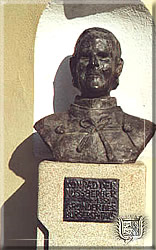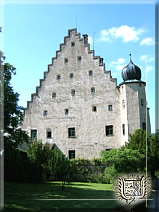| History of the House of Eggersberg |

|
Pre- and early history |
|
Even in
pre- and early history, the Altmühltal valley was a popular settlement
area because of its fertile side valleys, the rolling hills and the
streams, which were rich in fish
. Entire Celtic towns, so-called "oppida", were built around the 8th century bc. One was situated at "Wolfsberg" not far from Eggersberg. Further settlements were located at the foot of the castle rock . |
|
| This was proven with the find of a large Celtic burial ground during the construction of the Rhine-Main-Danube Canal. Among the burial objects was the longest Celtic bronze belt, which now is on display in the Hofmark Museum at Eggersberg. | |
10th century |
In the 10th century, the castle at Eggersberg was mentioned for the first time. |
|
|
12th century |
|
Eggersberg found its way into literature. The lords of Eggersberg Castle were the Nussbergers. They served the Counts of Bogen as so-called ministeriales (unfree knights).

|
|
|
Konrad von Nussberg
|
1st half of the 14th century
|
| Eggersberg Castle became the property of the Bavarian dukes, who gave it to the Lords of Wolfstein as a fief. At that time, the family Wolfstein of Sulzbürg was among the most important noble families in the district of the Upper Palatinate. In the course of the centuries they managed to raise from the position of imperial ministeriales to the position of imperial princes. |
 The
current coat of arms of Sulzbürg. The two red lions are a reminder of
the most important local noble family, the house of Wolfstein, who was
subject directly to the suzerainty of the Emperor. Their oldest signet,
known since 1292, shows two lions, one above the other. The one on the
top is shown pacing, the other one is up on its hind legs. Originally,
the background colour was silver. In 1740, the lineage of Wolfstein died
out, but the coat of arms of Sulzbürg and Pyrbaum still serves as a
reminder of the house.
The
current coat of arms of Sulzbürg. The two red lions are a reminder of
the most important local noble family, the house of Wolfstein, who was
subject directly to the suzerainty of the Emperor. Their oldest signet,
known since 1292, shows two lions, one above the other. The one on the
top is shown pacing, the other one is up on its hind legs. Originally,
the background colour was silver. In 1740, the lineage of Wolfstein died
out, but the coat of arms of Sulzbürg and Pyrbaum still serves as a
reminder of the house.
The first known member of the family was Gottfried of Sulzbürg (1259), who was mentioned as imperial ministerialis for the first time in 1217. With the administration of the imperial estates in the area of Neumarkt he acquired a good reputation and power. He was married twice with women of the high nobility, by which he was able to strengthen his authority and increase his possessions. As was customary among the high nobility, he founded the monastery Seligenporten and determined it to be the last resting place of his family. Gottfried of Sulzbürg-Wolfstein's high self-esteem was also reflected in the dispute over the throne in 1246/56, when he took sides with the antikings. In return he gained even more income. The death of Christian Albrecht, Count of Wolfstein, in 1740 marked the end of the male line of the family. As per contract, all the imperial estates administered by the Wolfstein family were transferred to the Electorate of Bavaria. After a protracted dispute, the Bavarian prince-elector even acquired the family's private property (allodia). |
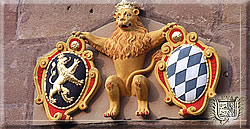
|
2nd half of the 14th century |
|
| The family of Hilpoltstein became the lords of Eggersberg Castle. | ||
|
City coat of arms of Hilpoltstein
|
||
| The city of Hilpoltstein, which is settled at the Main-Danube Canal and the lake Rothsee, has a history of more than 1,000 years. Heinrich von Stein and his son Hilpolt I of the family von Stein are considered to be the actual founders of the "oppidum in Lapide" in 1280. As imperial officials in the service of the House of Hohenstaufen and later of the House of Wittelsbach, they filled a powerful position. In his capacity as imperial official, Heinrich von Stein (1254-1265) administered the imperial estates in the Bavarian region of Franconia. | ||
14th century |
|
In the last third of the 14th century, the Hilpoltstein family sold Eggersberg Castle to the Lords of Lichteneck, who still exist in the lineage of the Counts of Preying-Lichteneck-Moos in Lower Bavaria. Eggersberg was in the family's possession only for a short time, though. When the Bavarian territories were partitioned between the sons of Duke Stefan in 1392, Eggersberg, Riedenburg, Stadtamhof, Reinhausen, Regenstauf, Schwandorf, Rieden, Velburg, Hemau and other places became the property of Duke John II of Bavaria-Munich . |
End of 14th century |
| Knight Wilhelm of Fraundorf and later Knight Ulrich Muracher acquired Eggersberg Castle. The Muracher family, which also owned Flügelsberg Castle on the other side of Eggersberg, excelled in their support of the so-called "Löwlerbund" in the rebellion against Duke Albert of Bavaria. |
1417 |
|
Balthasar Muracher was still mentioned as lord of Eggersberg Castle. The members of the Muracher family were dreaded robber-barons. Even in 1561, a Bavarian chronicle mentioned the unscrupulous ways in which the nobility exploited the people. In
those days, the Muracher were known for their notorious raids and bloody
feuds in the entire surrounding area. Konrad Muracher of Flügelsberg was
captured by the Knight Heydeck in the course of their feud and kept
imprisoned from 1385 to 1394. Ulrich von Murach robbed merchants from
Augsburg in 1407. Jörg, Friedrich and Erhart von Murach even raided and
robbed Helfenberg Castle near Velburg, whereby they benefited from the
fact that the owner, Prince-Elector Louis III, had died in December
1436.
|
1435 |
|
Duke William of Bavaria gave Hexenagger Castle, which lies in the Schambachtal valley, to the Muggenthal family as a fief in 1529. The Muggenthal family distinguished itself. Hexenagger Castle and the appertaining chapel had been destroyed by the Swedes during the Thirty Years' War, but Erhart von Muggenthal rebuilt them in 1625/29. In the course of the following centuries the Muggenthalers were raised to the position of barons of the empire. |

|
In 1480, |
|
| Marshal Georg von Pappenheim became the new owner of Eggersberg Castle, but only a few years later, in | ||
|
County of
Pappenheim
|
|
|
|||
1485
|

|
||
|
he sold
it to Count Jörg von Helfenstein. The count did not show much
interest in the castle, though, and left it to decay. Instead, he
dedicated his time to his new wife, the widow of Johann von Hexenagger.
With this marriage he came into the possession of Hexenagger Castle
.
|
|||
|
Countess
Helfenstein begs ringleader Jäcklein Rohrbach to spare her husband
during the Peasants' War. Copper engraving by Matthäus Merian Sr |
|||
|
|
Mid 16th century
|
|
|
Eggersberg Ca.tl. was described as "desolate and decayed". It probably had been damaged during the "Löwler War". The "Löwlerkrieg" |
||
|
Duke Albert IV (the Wise) raised a general tax to recruit and pay a standing army in 1488. The Parsbergers of Flügelsberg and other fief-holding noble families of Lower Bavaria insisted on their privileges and rejected the tax. Instead they demanded full tax exemption for their rank. Duke Albert rejected such a notion energetically, though. As a result, 46 knights met in Cham and founded the "Knight's alliance of the lion", the "Löwlerbund", with the objective of rising up against the duke. The number of the knights proliferated in no time and the division in the country grew deeper day by day. Even the duke's younger brothers joined the Löwlerbund because the duke did not acknowledge their claims to power. The knights attempted an open revolt against Duke Albert in October 1491, because they believed to outnumber the duke's supporters. They raided and robbed the duke's estates and villages in the area of Regensburg and captured his people. Meanwhile, the duke gathered all his supporters and allies in order to quench the revolt. On 21 December 1491, together with an army of 2,000 men and 30 artillery pieces he went from Munich to Regensburg to put an end to the outrageous actions of the Lion Knights.
After order had been restored in the area of Regensburg, the duke and
his men moved on to Prunn, Riedenburg, Eggersberg, Flügelsberg and
Ehrenfels near Beratzhausen. At Flügelsberg were the headquarters of the
Lion Knights and many of them stayed there. To provide for their living
plenty of food had been taken from the raided ducal villages. |
||
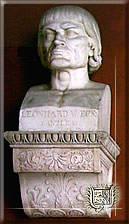
|
16th centuryIn the first third of the 16th century, Leonhard von Eck (1480-1550) was given the Hofmark Eggersberg and the Hofmark Wolfseck. A Hofmark was the smallest jurisdiction of the country at that time. He was one of the most important Bavarian politicians of the time. His complex policy, always focused on the welfare of his lord and Bavaria, made an impact and received credit well beyond the Bavarian borders.Leonhard von Eck, who was of lower nobility that was not allowed to take part in tournaments, received his Doctor of Both Laws (iuris utriusque) in Bologna. Duke William IV of Bavaria appointed him into his government in 1514. There the court councillor ("first daily councillor") was the duke's closest adviser and therefore the most important figure at the Bavarian court. For over 35 years, he influenced the political, economic, religious and social life in Bavaria in the first half of the 16th century. The first effective approaches to a central government in Bavaria came from Leonhard von Eck. It was also due to his work, that Bavaria stayed Catholic and later on became the most important Catholic power in Germany. He had laid the foundation. |
|
|
Bust of
Leonhard von Eck in the Hall of Fame in Munich
|
||
|
At
Eggersberg and at Wolfseck Leonhard von Eck was described as followes:
William IV of Bavaria appointed him into his governmental body in 1514. Eck received the title "Daily Councillor of Munich", free lodging, a winter and a summer garment as well as two horses.
As
"daily councillor" he had to be available every single day in contrast
to the "requested councillors", who were of nobility that was admitted
to tournaments. Those had to make an appearance only when called upon.
And then there were the "ember days councillors", who were called to
court only four times a year. The daily councillors had the most
influence, of course, and Eck was the most important of them.
Still, things worked out between those two strong-willed fellows, not least because the duke realised that he could leave the daily business to Councillor Leonhard von Eck and instead enjoy the pleasures of life. He had time for art, hunting (for example at Eggersberg, which lay in a densely forested area with much game), tournaments and culinary delights. Both men were in agreement that two principles should have priority in Bavarian policy: Containment of the house of Habsburg's urge for territorial expansion and the fight against the Reformation. Thus, the Bavarian Chancellor Leonhard von Eck became one of the most violent opponents of the Habsburg Emperor Charles V. The humanist statesman Leonhard von Eck was actually quite liberal. He took the view that everybody should be entitled to believe in what their conscience tells them to. Officially though, he extended the power of the Catholic Church in Bavaria with all his might.
He
coined the phrase "Cuius regio, eius religio", whoever rules the
country also determines its religion. Immediately after the emperor had
placed Martin Luther under the imperial ban, Leonhard von Eck started
the confessionalization in a systematic way. He created the early
absolutist state, in which the political and religious identity merged.
Therefore, Eck kept a jealous watch over his lord's favour. The
ambitious chancellor lived in constant fear of a possible comedown. Even
after thirty years he still felt uneasy whenever the duke sent his
"daily councillors" some venison without being distinguished with an
especially large piece. |
||
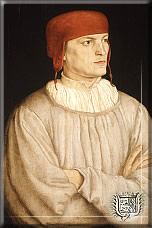
|
Chancellor Leonhard von Eck (1480-1550),
1527, by Barthel Beham (German, 1502-1540) Oil on wood; 22 1/8 x 14 7/8 in. (56.2 x 37.8 cm) Collection John Stewart Kennedy Fund, 1912 |
|
| Literature: | |
|
|
Bibliographie zur deutschen Geschichte im Zeitalter der Glaubensspaltung 1517-1585, published by Karl Schottenloher Volume III, Reich und Kaiser, Territorien und Landesherren, Leipzig 1936 No. 29422-29437, Karl Schottenloher Volume V, |
|
|
Karl Schottenloher Geschichte Baierns, 8 Volume, II-VIII Gotha 1880-1914; I Stuttgart 2 1927, Volume IV; |
|
|
Walter Peter Fuchs, Baiern und Habsburg 1534-1536, in ARG 41 (1948), 1-32; - ARC I et seq.; |
|
|
Das konfessionelle Zeitalter. Erster Teil: Die Herzöge Wilhelm IV. und Albrecht V., in: Handbuch der Bayerischen Geschichte published by Max Spindler, Volume 2 München 1969, 297-346, here: 227-335 |
1595
|
|
|
On Leonhard von Eck followed the jurist, ducal councillor and carer of the city of Dachau, Wilhelm Jocher von Egersperg, who carried his new possession in his name. He was born in Mauterndorf, Salzburg on 15 November 1565 and died in Munich on 3 May 1636. He
initiated the construction of the new Eggersberg Castle, which was
completed, according to carpenter fittings in the roof truss, in 1604. |
|
| 1604 trat er in die Dienste Herzog Maximilians I. 1611 wurde er zum Geheimen Rat ernannt. Als wichtigster Ratgeber Maximilians begleitete der humanistisch gebildete, streng religiöse Jocher die bayerische Reichs- und Außenpolitik mit scharfsinnigen, bisweilen spitzfindigen juristischen Stellungnahmen. | |
|
In 1604,
he entered into service with Duke Maximilian I. In 1611 he was appointed
privy council. The devout Jocher, who had received a humanist education,
became Maximilian's most important counsellor and as such gave his
juristic advice on the Bavarian foreign and imperial policy with
subtlety and astuteness. After defending the Aulic Council in the
Donauwörth dispute he even came into favour at the imperial court. In
1620/21, he advised the emperor on the proscription of Frederick V.
Between 1621 and 1628, Jocher acted as violent opponent of the Palatine
councillor Ludwig Camerarius in the chancery dispute. With his sense of
realistic possibilities Jocher repeatedly stood in contrast to Duke
Maximilian's doctrinaire confessor Contzen, not least in the matter of
witch persecution. Contzen supported the witch persecution whereas
Jocher demanded its containment. In 1636, Jocher died in Munich. His son Adam Jocher, who was ducal councillor himself, had the ruinous old castle knocked down. Instead, he moved into the "New Eggersberg Castle", as it still exists today. |
|
1684
Adam Jocher von Egersperg overextended himself and went broke. What
followed was the forced sale of Eggersberg. His nephew Baron Thomas von Bassus was a leading member of the infamous "Order of Illuminati", together with Adam Weishaupt, who used the codename "Spartacus". Weishaupt's adjutant was Baron Adolph Franz Friedrich Ludwig von Knigge, who significantly helped to spread the Illuminati among nobility.
|
|||
|
|
Copper
engraving of Eggersberg Castle by Michael Wening. The coat of arms of
the de Bassus family is shown on the top left. The family had left their
mark back in Poschiavo as patrons of the art and benefactors and they
kept up this tradition in Bavaria. The family acted as patron of the
famous composer Johann Simon Mayr and wood-carver Ignaz Günther.
|

|
|

|
|
On 22 November 1725 the Rococo sculptor Ignaz Günther was born in Altmannstein in the Upper Palatinate. At the age of 18 he was accepted to the atelier of the court sculptor Johann Baptist Straub in Munich. There, he acquired his sense for technical refinement and a certain nervous elegance, which made many of his works so popular. | ||||||||||||||||||||||||||||||||||
|
Ignaz Günther
|
||||||||||||||||||||||||||||||||||||
|
In 1750,
he travelled around to Salzburg, Mannheim, Olmütz in Marovia and Vienna.
There, he won the first prize of the Imperial Academy. In 1754, he moved
to Munich, married and bought the house number 11 on the street "Am
Unteranger". He celebrated great successes, but died at the age of only
50 years in 1775.
Ignaz Günther, who also was promoted by the Barons de Bassus, represented the peak and simultaneously the end of the Bavarian Rococo sculpture. Some of the most important works of the carver and sculptor Ignaz Günther:
|
||||||||||||||||||||||||||||||||||||
1726Baron Joseph von Bassus, lord of the Hofmarks Sandersdorf, Harlanden, Eggersberg and Tachenstein, had the Holy Cross Chapel built in Obereggersberg. A simple monstrance of that chapel, which contains a verified particle of the True Cross, is shown in the "Hofmark-Museum" of the Robert Weigand Cultural Foundation in the "stables" of Eggersberg Castle |
1806Part of the chapel fell down because of inadequate maintenance. A chapel was set up in the castle, which was deconsecrated a few years later. It was replaced with the chapel in the old presbytery. The presbytery, an axial building which belongs to the castle, had been constructed by the well-known master builder Gabriel di Gabrieli by order of the barons de Bassus in 1722.
(In
1805, following Baden-Wuerttemberg, Bavaria became kingdom by Napoleon's
grace.)
|
1962Dr. jur. utr. Robert F.E. Weigand ( founder and honorary chairman of the Bavarian committee of the German castle association, founding member of the Bavarian Monument Council/Monument Council of Bavaria etc.) bought Eggersberg Castle. He transformed it into a hotel and restaurant business and set up the Hofmark Museum. The first person, who rented the castle from Dr. Weigand in order to run a hotel and restaurant, was again a Baron Knigge . |
